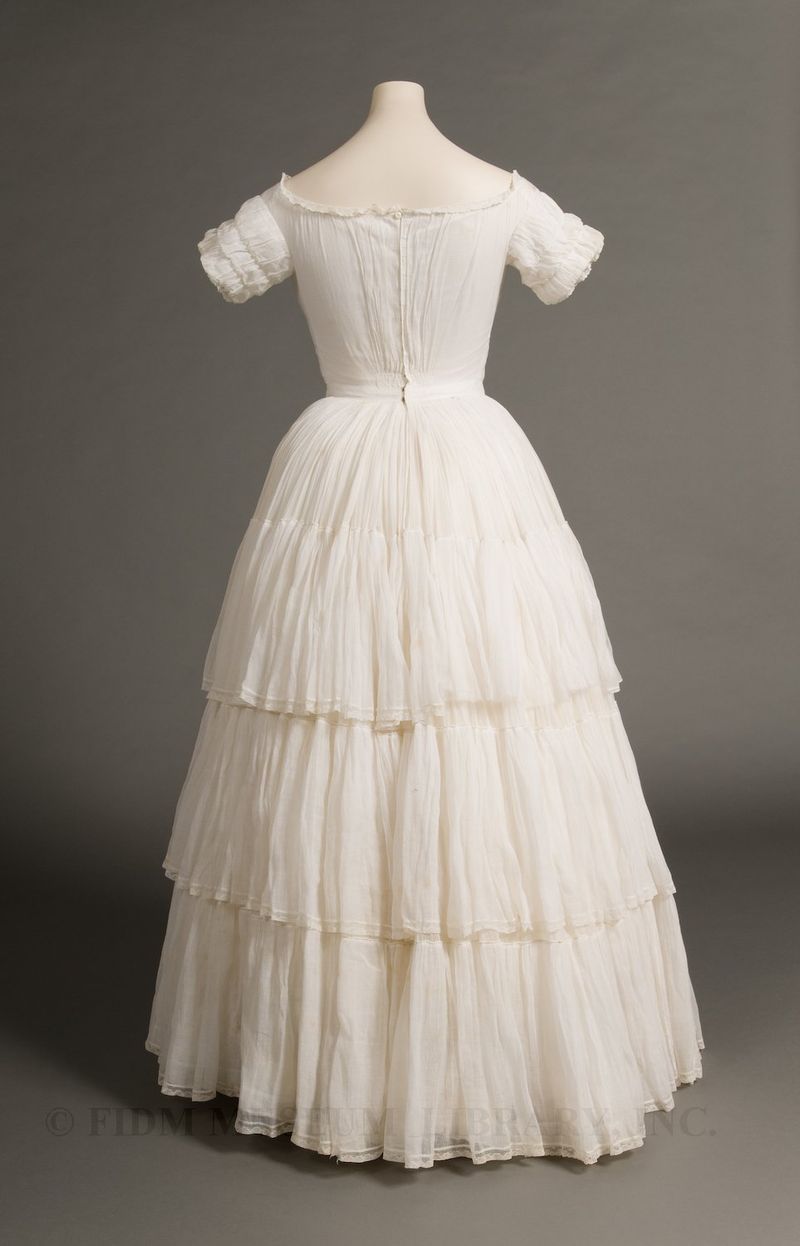The ideal 1840s woman was a delicate being. She was innocent, modest, sensitive to etiquette, possessed of softly rounded shoulders and had a demure gaze. According to one 1843 description, proper young women, "never go into a passion, have no will of their own, never laugh out loud, or go anywhere without a gentleman, or take cheese at dinner."1 As with any archetype, there were probably women who didn't fit the ideal. Factory girls working in the mills of New England, settlers exploring the Oregon Trail, and the working poor were probably forced to ignore some of these qualities due to circumstance. Despite these and other exceptions, the 1840s ideal strongly suggested that a woman should be subdued, fragile and sentimental. This 1840s dress, made from diaphanous white cotton muslin edged with bobbin lace, suggests these qualities.
 c.1845
c.1845
Gift of Ann Jensvold
2003.793.10
Measuring 52 inches at the center back, this dress was probably worn by an adult woman, or a very tall adolescent. Though made from extremely lightweight cotton, typically a daytime fabric, the wide scooped neckline and short, puffed sleeves are cut along the lines of an evening gown. Period fashion plates suggest that for day wear, it might have been worn with a tucker. Look closely at the figure on the left in this 1845 fashion plate to see how a tucker provided additional coverage for the shoulders. Note also her fingerless mitts, which are similar to those seen in this post. If worn for evening, a white dress was an extremely young style, as "clear white muslin was popular as youthful evening wear."2
With its subtle detailing, this dress was a perfect canvas for displaying accessories. In an 1841 fashion plate, white dresses predominate, enlivened by pink and blue highlights. In this 1846 fashion plate, a white gown is accented with pink flowers and a blue fringed parasol. An 1845 fashion plate features a white dress paired with a blue floral headpiece and small blue flowers on the sleeves. These plates also demonstrate the preference for white, pink and blue, soft colors appropriate for a demure lady. Also note the extreme slope of the shoulders. What happened to their bones?
Fashion changed less frequently in the 1840s. Instead of monthly or weekly updates, styles changed more gradually, with few dramatic changes to the silhouette throughout the decade. The pleated "fan-front" bodice ending in a sharp V, natural waist placement, and tiered skirt seen on our dress were consistent features of 1840s dress. Skirts were long and hid the wearer's feet. Underneath, a corset, layers of petticoats, or the newly introduced crinoline, supported the silhouette. Corsets of this decade fastened in the back, compressed the bust and extended to the lower abdomen and hips. Like most dresses, they fastened in the back, necessitating the help of a friend, family member or maid for proper dressing.
1 Cunnington, C. Willet. Fashion and Women's Attitudes in the Nineteen Century. Courier Dover: London. 2003: 114-115.
2 Buck, Anne. Victorian Costume and Costume Accessories. Ruth Bean Publishers: Bedford, UK. 1984: 23.



Never take cheese at dinner! I’m glad I’m not an 1840s woman, as much as I love the fashions…
This dress is beautiful in its simplicity; but I am stunned by the black gown in the 1845 plate. Again, simple, but with some special touches.
Isn’t the anti-cheese statement funny? I agree about the simplicity of the dress and the one pictured in the fashion plate. You can really focus on the dress itself. That fashion plate is from the Los Angeles Public Library Casey Fashion plate collection, which is really extensive. You can search the collection here: http://www.lapl.org/resources/indexes/casey.html